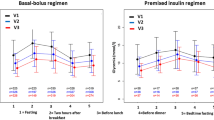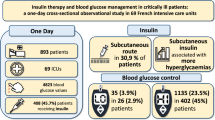Abstract
Objective
Intensive insulin therapy reduces mortality in subgroups of intensive care unit (ICU) patients, and awareness of the importance of blood glucose level (BGL) control has increased among ICU physicians and nurses. The impact of insulin treatment strategies on mortality may be influenced by their efficacy in achieving the target BGL range. We assessed the efficacy of an insulin treatment strategy in maintaining BGL within the target range, and we compared ICU mortality in patients who did and did not reach the BGL target.
Design
Prospective cohort study.
Setting
12-bed medical ICU in a tertiary teaching hospital.
Patients and participants
Adults consecutively admitted over a 9-month period to an ICU where standard care included an insulin treatment strategy aimed at maintaining BGL ≤ 7 mmol/l.
Measurements and main results
105 patients were included. Median SAPS II was 45 (31–54). Failure to control BGL (mean capillary BGL > 7 mmol/l after initial hyperglycemia correction) occurred in 32 patients (31.1%) and was associated with a significant increase in ICU mortality (56.2 vs. 23.3% in patients with successful BGL control). In the multivariate analysis, failure to control BGL independently predicted death in the ICU (OR 5.9, 2.1–16.6, p < 0.001).
Conclusions
Failure to control BGL despite intensive insulin therapy was common and independently associated with ICU mortality. Failure to control BGL may considerably affect the overall impact of insulin treatment strategies on mortality.


Similar content being viewed by others
References
Malmberg K, Norhammar A, Wedel H, Ryden L (1999) Glycometabolic state at admission: important risk marker of mortality in conventionally treated patients with diabetes mellitus and acute myocardial infarction: long-term results from the Diabetes and Insulin-Glucose Infusion in Acute Myocardial Infarction (DIGAMI) study. Circulation 99:2626–2632
O'Neill PA, Davies I, Fullerton KJ, Bennett D (1991) Stress hormone and blood glucose response following acute stroke in the elderly. Stroke 22:842–847
Scott JF, Robinson GM, French JM, O'Connell JE, Alberti KG, Gray CS (1999) Glucose potassium insulin infusions in the treatment of acute stroke patients with mild to moderate hyperglycemia: the Glucose Insulin in Stroke Trial (GIST). Stroke 30:793–799
Sung J, Bochicchio GV, Joshi M, Bochicchio K, Tracy K, Scalea TM (2005) Admission hyperglycemia is predictive of outcome in critically ill trauma patients. J Trauma 59:80–83
Digman C, Borto D, Nasraway Jr SA (2005) Hyperglycemia in the critically ill. Nutr Clin Care 8:93–101
Mizock BA (2001) Alterations in fuel metabolism in critical illness: hyperglycaemia. Best Pract Res Clin Endocrinol Metab 15:533–551
Wolfe RR, Herndon DN, Jahoor F, Miyoshi H, Wolfe M (1987) Effect of severe burn injury on substrate cycling by glucose and fatty acids. N Engl J Med 317:403–408
Christiansen C, Toft P, Jorgensen HS, Andersen SK, Tonnesen E (2004) Hyperglycaemia and mortality in critically ill patients. A prospective study. Intensive Care Med 30:1685–1688
Krinsley JS (2003) Association between hyperglycemia and increased hospital mortality in a heterogeneous population of critically ill patients. Mayo Clin Proc 78:1471–1478
Pittas AG, Siegel RD, Lau J (2004) Insulin therapy for critically ill hospitalized patients: a meta-analysis of randomized controlled trials. Arch Intern Med 164:2005–2011
van den Berghe G, Wouters P, Weekers F, Verwaest C, Bruyninckx F, Schetz M, Vlasselaers D, Ferdinande P, Lauwers P, Bouillon R (2001) Intensive insulin therapy in the critically ill patients. N Engl J Med 345:1359–1367
van den Berghe G, Wilmer A, Hermans G, Meersseman W, Wouters PJ, Milants I, Van Wijngaerden E, Bobbaers H, Bouillon R (2006) Intensive insulin therapy in the medical ICU. N Engl J Med 354:449–461
McMullin J, Brozek J, Jaeschke R, Hamielec C, Dhingra V, Rocker G, Freitag A, Gibson J, Cook D (2004) Glycemic control in the ICU: a multicenter survey. Intensive Care Med 30:798–803
Lacherade JC, Grimaldi D, De Jonghe B, Theron V, Lemoullec M, Outin H (2004) Achievement of glycemic control under insulin therapy in a medical ICU: impact of mortality (abstract). Am J Respir Crit Care Med. 169:A39
Thuong M, Letreutre S (2003) Experts recommandations of the Société de Réanimation de Langue Française: enteral nutrition in critical care. Réanimation 12:350–354
Le Gall JR, Lemeshow S, Saulnier F (1993) A new Simplified Acute Physiology Score (SAPS II) based on a European/North American multicenter study. J Am Med Assoc 270:2957–2963
Goldberg PA, Siegel MD, Sherwin RS, Halickman JI, Lee M, Bailey VA, Lee SL, Dziura JD, Inzucchi SE (2004) Implementation of a safe and effective insulin infusion protocol in a medical intensive care unit. Diabetes Care 27:461–467
Kanji S, Singh A, Tierney M, Meggison H, McIntyre L, Hebert PC (2004) Standardization of intravenous insulin therapy improves the efficiency and safety of blood glucose control in critically ill adults. Intensive Care Med 30:804–810
McCowen KC, Malhotra A, Bistrian BR (2001) Stress-induced hyperglycemia. Crit Care Clin 17:107–124
Van den Berghe G (2004) How does blood glucose control with insulin save lives in intensive care? J Clin Invest 114:1187–1195
Marik PE, Raghavan M (2004) Stress-hyperglycemia, insulin and immunomodulation in sepsis. Intensive Care Med 30:748–756
Van den Berghe G, Wouters PJ, Bouillon R, Weekers F, Verwaest C, Schetz M, Vlasselaers D, Ferdinande P, Lauwers P (2003) Outcome benefit of intensive insulin therapy in the critically ill: insulin dose versus glycemic control. Crit Care Med 31:359–366
Grey NJ, Perdrizet GA (2004) Reduction of nosocomial infections in the surgical intensive-care unit by strict glycemic control. Endocr Pract(Suppl.) 10(2):46–52
Finney SJ, Zekveld C, Elia A, Evans TW (2003) Glucose control and mortality in critically ill patients. J Am Med Assoc 290:2041–2047
McMahon MM (2004) Management of parenteral nutrition in acutely ill patients with hyperglycemia. Nutr Clin Pract 19:120–128
Acknowledgements
We are indebted to the ICU nursing staff for their contribution to the development and implementation of the intensive insulin therapy procedure used in this study.
Author information
Authors and Affiliations
Corresponding author
Appendix
Appendix
Insulin infusion procedure for ICU nurses. Goal: to maintain blood glucose level between 5 and 7 mmol/l. ICU intensive care unit, BGL blood glucose level, IV intravenous, IVP intravenous push.
Initiating the insulin infusion
Continuing the insulin infusion
Rights and permissions
About this article
Cite this article
Lacherade, JC., Jabre, P., Bastuji-Garin, S. et al. Failure to achieve glycemic control despite intensive insulin therapy in a medical ICU: incidence and influence on ICU mortality. Intensive Care Med 33, 814–821 (2007). https://doi.org/10.1007/s00134-007-0543-0
Received:
Accepted:
Published:
Issue Date:
DOI: https://doi.org/10.1007/s00134-007-0543-0




